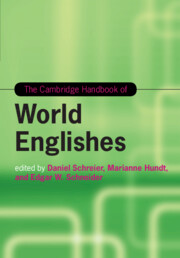Book contents
- The Cambridge Handbook of World Englishes
- Cambridge Handbooks in Language and Linguistics
- The Cambridge Handbook of World Englishes
- Copyright page
- Dedication
- Contents
- Figures
- Maps
- Tables
- Notes on Contributors
- 1 World Englishes: An Introduction
- Part I The Making of Englishes
- Part II World Englishes Old and New
- Part III Linguistics and World Englishes
- 14 The Global Growth of English at the Grassroots
- 15 Beyond English as a Second or Foreign Language: Local Uses and the Cultural Politics of Identification
- 16 World Englishes in Cyberspace
- 17 World Englishes and Their Dialect Roots
- 18 Lexicography and World Englishes
- 19 The Relevance of World Englishes for Variationist Sociolinguistics
- 20 Multilingualism and the World Englishes
- 21 Unearthing the Diachrony of World Englishes
- 22 Corpus-Based Approaches to World Englishes
- 23 World Englishes from the Perspective of Dialect Typology
- 24 Language Acquisition and World Englishes
- Part IV Current Challenges
- Index
- References
16 - World Englishes in Cyberspace
from Part III - Linguistics and World Englishes
Published online by Cambridge University Press: 16 December 2019
- The Cambridge Handbook of World Englishes
- Cambridge Handbooks in Language and Linguistics
- The Cambridge Handbook of World Englishes
- Copyright page
- Dedication
- Contents
- Figures
- Maps
- Tables
- Notes on Contributors
- 1 World Englishes: An Introduction
- Part I The Making of Englishes
- Part II World Englishes Old and New
- Part III Linguistics and World Englishes
- 14 The Global Growth of English at the Grassroots
- 15 Beyond English as a Second or Foreign Language: Local Uses and the Cultural Politics of Identification
- 16 World Englishes in Cyberspace
- 17 World Englishes and Their Dialect Roots
- 18 Lexicography and World Englishes
- 19 The Relevance of World Englishes for Variationist Sociolinguistics
- 20 Multilingualism and the World Englishes
- 21 Unearthing the Diachrony of World Englishes
- 22 Corpus-Based Approaches to World Englishes
- 23 World Englishes from the Perspective of Dialect Typology
- 24 Language Acquisition and World Englishes
- Part IV Current Challenges
- Index
- References
Summary
The New Englishes, including many nonstandard varieties, have developed a massive presence in cyberspace, which – as a result – is establishing itself as a sociolinguistic domain in its own right. This domain is partly autonomous and innovative in the way in which speakers respond to the demands and opportunities of the new medium but nevertheless remains connected to the sociolinguistic norms that regulate offline language use in the global “English Language Complex.” From a World Englishes perspective, the specific challenges presented by computer-mediated communication (CMC) are (1) the unprecedented levels of linguistic, textual, and discursive mobility that the new technologies have made possible and (2) the hybrid and multilingual practices that they have encouraged. This new mobility is demonstrated in case studies involving English-lexifier pidgins and creoles from West Africa and the Caribbean and Spanish-English code-switching. The notion of languagescape(s) is proposed to account for the new transnational contacts and connections among standard and nonstandard Englishes that have emerged in the wake of the Digital Revolution.
Keywords
- Type
- Chapter
- Information
- The Cambridge Handbook of World Englishes , pp. 360 - 383Publisher: Cambridge University PressPrint publication year: 2020
References
- 2
- Cited by



